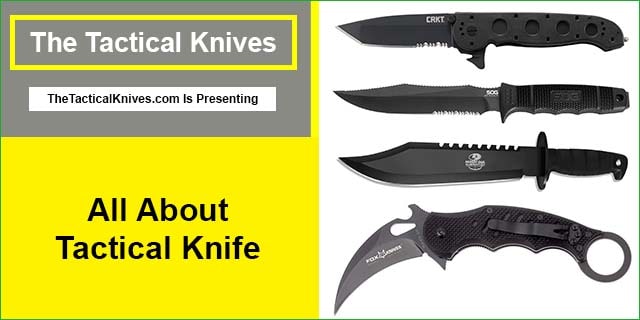Knives have been both a utility device and a weapon for as long as they have existed. With the first blade being dated from 1.4 million years ago, knives have come a long way.
Over the centuries, different types of knives have been invented for different needs. At the present time, among these, the tactical knife occupies a special place among knife enthusiasts.
But many people have various questions and misconceptions about the tactical knife. So in this article, I will try to give you a clear, and accurate idea about tactical knives.
What Is a Tactical Knife?
Tactical knives are a subset of knives focused around combat. While they retain utilitarian capabilities, their construction lends them to be more effective in combat than other knives and blades.
The tactical knife is the most preferred and effective of all types of combat knives currently issued to soldiers of various countries for knife warfare.
Most of the best tactical knives are medium in size (8″-12″), will often have a guard, a non-reflective coating on the blade, a centered balance, a pointed or spiked pommel, and are designed for military use. Not all knives classified as tactical will hold all the same characteristics, however, all will match at least one.
Tactical knives are further split into “fixed blade” and “folding blade” knives.
What Is a Tactical Fixed Blade Knife?
Tactical fixed blade knives are just as they seem, a knife that doesn’t fold and typically has a single blade affixed permanently to a handle.
An ideal fixed blade knife has a tang, which is the part of the blade that permanently connects the blade to the handle. A tang extends fully or partially throughout the handle. Full, extended, and partial types of tangs are usually more common in tactical fixed blades. But the most durable and popular is the full tang knife.

This typically allows for the blade to be more durable and better balance when compared with knives without tangs.This is important as tactical fixed blade knives tend to be used more for heavy-duty work such as chopping, skinning, stabbing, or any activity that requires an excess of force.
Moreover, the best tactical fixed blades can still perform well at other tasks, some even prefer them when it comes to survival, combat, or self-defense. This is because fixed tactical knives are strong, easy to use, and equip.
Generally, tactical fixed blade knives come with a sheath. Along with protecting the knife, a sheath aids in carrying a fixed blade, as it can be attached and worn. A sheath can be made from leather, plastic, Kevlar, nylon, or other materials. When the knife needs to be used, it just requires being removed from its sheath.
Some examples of tactical fixed blades are karambits, machetes, bushcraft knives, and bowie knives.
What Is a Tactical Folding Knife?
Tactical folding knives incorporate a folding mechanism where the blade can close into the knife’s handle via a hinge. Nowadays, all the best tactical pocket knives have a locking mechanism and in most cases an assisted opening mechanism as well.
You May Like: Best Spring Assisted Folding Tactical Knife
Folding blades have some advantages over fixed blades, including a subtle appearance and convenient storage. The discreet design of a folding blade allows this knife to operate stealthily and with an element of surprise.

Foldability creates a compact knife for storage purposes and most of them have a pocket clip and eliminate the need for a sheath.
A considerable advantage of tactical folding blade knives can be found in their widely accepted use and legality. Many jurisdictions regulate fixed blades more rigorously than they do folding blades.
Folding blade tactical knives are an excellent choice for a knife on the go that is inconspicuous and will be sure to comply with regulations almost anywhere.
What Is the Origin of Tactical Knife?
Knives and tools have been around for centuries, so it’s only logical to infer that tactical knives have been around for just as long.
The first sign of a knife being used for tactical purposes dates back to the bronze age (3300 BC – 1200 BC). Since knives have been around for such a long time it’s hard to pinpoint which civilization invented them.
However, from the history of tactical knives, we know that the term “tactical” wasn’t popularized until around the 1990s.
As for the founder of the modern tactical knife, enthusiasts debate between Bob Terzuola (inventor of folding knives), Ernest Emerson (custom knife maker), and Greg Walker (popularized tactical knives).
Related Post: The History of the Bowie Knife
What Does “Tactical” Mean in Knives?
The term “tactical” separates a tactical knife from other knives in more than just name. Tactical refers to knives which are suited for “battlefield” or military tasks.
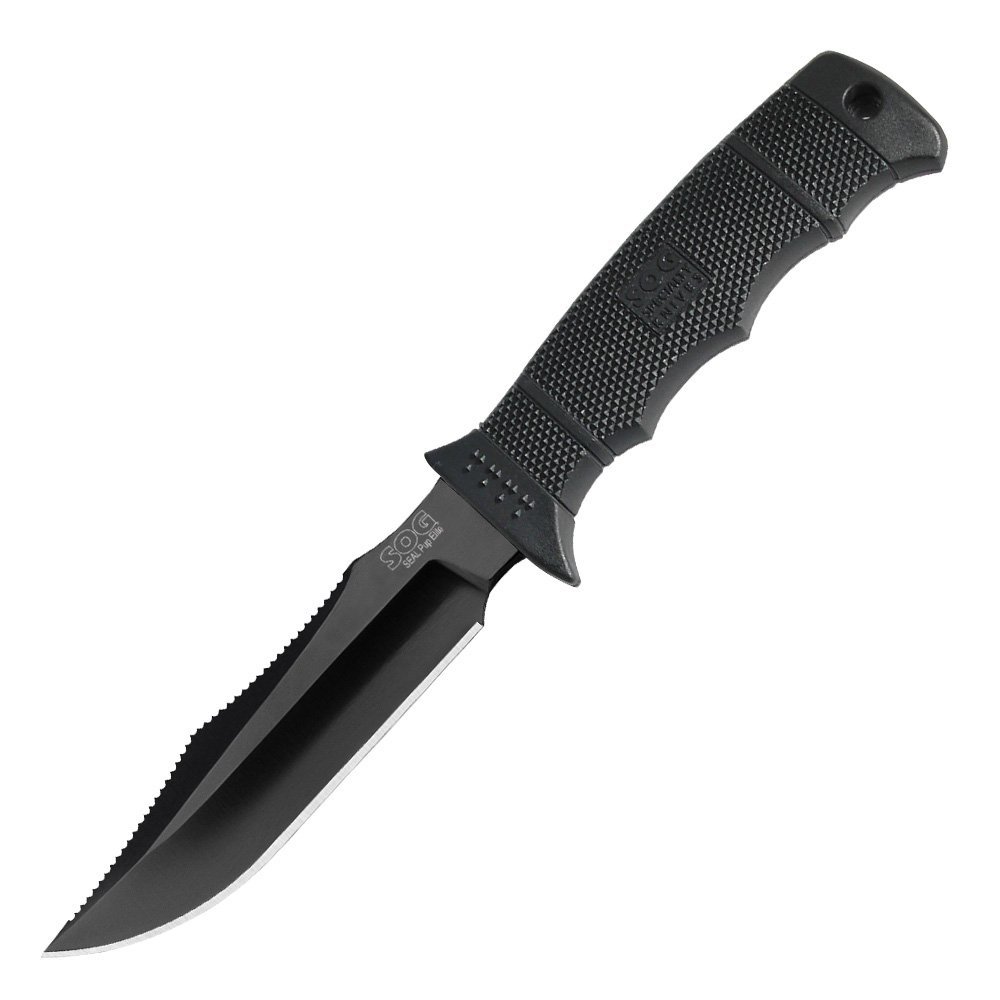
These knives are able to stab, slice through a variety of materials, break glass, and generally be used to survive. Their blades are of a stronger material than survival or standard knife and have an ergonomic grip optimized for any wielding position without being slippery or difficult to hold.
What Makes a Knife Tactical?
Differing from other knives, a tactical knife holds many denotations. Originally being distinguishable by their tanto serrated style blade, blades are now more varied and harder to tell apart from other knives.
However, tactical knives still have other key components that separate them from the ordinary. Tactical knives are by far more durable than regular knives and are designed to be able to handle heavy-duty and high-impact tasks.
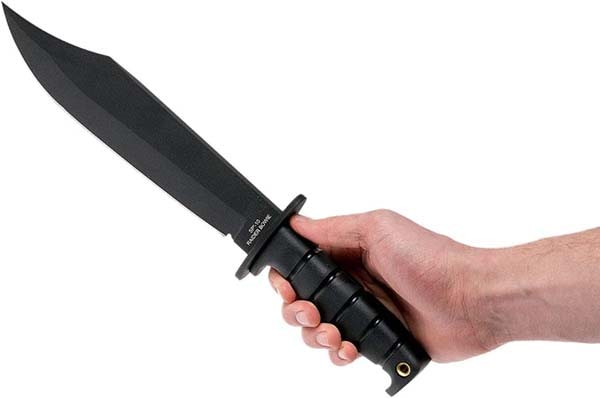
Their blades should be pointed, and their handle should be ergonomic and composite or synthetic material. If a knife has a slippery grip, it is not a tactical knife. Ergonomic grips make it possible to hold the knife in a variety of different grips and applications, and should be smooth yet not slippery.
Additionally, a tactical knife should not have a reflective or shiny blade, for this would be a detriment on the battlefield as glare from the blade could give a position away.
While some knives called “tactical” don’t adhere to these requirements, the best tactical knives will.
What Are Tactical Knives Made Of?
As previously mentioned, the durability of a tactical knife is one of the key characteristics which define it. As such, it requires high-quality knife steel and other materials.
While materials have varied through the years, and vary through models, blades will be constructed of high quality high carbon, and correctly heat-treated steel. This material can lend the knife to break or warp if prying objects or using the blade as a lever.
Although some blades are made from less high carbon stainless steel, such as tool steel and stainless steel blades. These blades take longer to sharpen and have less edge retention.
Additionally, the blade should have a good coating that blocks reflections and should be frictionless. While a friction-less coating is not required, it makes cutting materials or removing a blade easier.
The handle of the blade should be composite material and mildly textured. Most handles are currently synthetic, however, leather, brass, or aluminum is not uncommon.
What Makes a Good Tactical Knife?
Quality tactical knives will vary depending on the intended purpose. Knives intended for combat should have a strong point, a grip that won’t absorb or slick with sweat, and a durable blade and tang.
Folding knives are less ideal for combat due to their lower durability in high-impact scenarios, however, can serve if needed.
For more utilitarian purposes, a good knife should be able to withstand torque and pressure, have a versatile and smooth grip for all situations, and should be able to cut through a variety of materials, whether hard or soft.
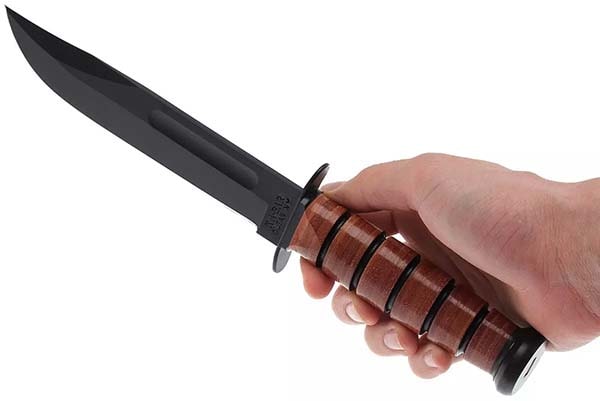
Tactical knives in general tend towards the smaller side, and size matters when considering a good blade. Smaller blades are more portable, however, are not as heavy or suited for hard tasks.
Large blades, however, while suited for heavy tasks and will more easily cut through materials, are more difficult to conceal and are less ideal for casual carry.
A good knife, for all situations, will find a good middle ground, and be small and easily concealable, while able to tackle heavy tasks. Otherwise, a good knife will vary by use and purpose.
Ultimately, a good tactical knife will have a solid, universal grip resistant to moisture, a durable and pointed blade, and will be suited for every situation and task.
What Is a Tactical Knife Used For?
Tactical knives are able to be used for any task one could encounter on a battlefield or emergency survival situation or everyday utility chores.
They can be used to cut a variety of materials, rope, paracord, netting, mesh, seat belts, electric wires, branches, and animal flesh, and are capable of piercing hard objects as well.
Fixed blade knives can be used to dig, slice, chop, baton, stab, hammer, smash objects, or pry them apart. Fixed blade knives are better suited for use in combat than folding knives.
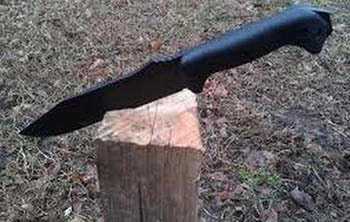
However, folding knives can be easily carried to be used in more situations, while still fulfilling other uses.
Tactical knives are designed to be multi-functional without compromise. They are not suited for skinning and butchering animals but can be used to slash through thick undergrowth or flora.
How Much Does a Tactical Knife Cost?
The tactical knife price is not too high almost like other knives. However, depending on the quality of the knife, their price is more or less. Besides, the price of a fixed blade is slightly higher than a folding knife.
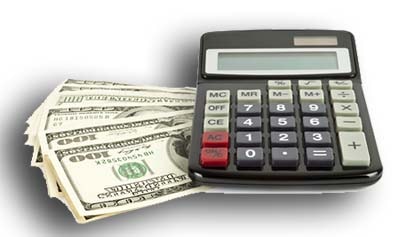
If you are a casual user you may prefer knives between $20-$50; try to get a knife in the $50-$100 range for some regular and moderately heavy use; professionals or heavy users should try to buy American-made heat-treated high carbon steel knives which can cost more than $100.
When we are talking about the price range of the product let me inform you that if you want a pocket knife for everyday carry and use then you can check out the following articles written by me –
- Best Affordable EDC Knife
- Best USA Made EDC Knife Under $50
- Best Tactical Knife Under $100
- Best EDC Knife Under $300
- Best Fixed Blade Knife Under $200
How to Hold a Tactical Knife?
Unlike some other knives, tactical knives are designed to be held in nearly any way. While some cater to specific styles of grip, such as a hammer grip or index-reliant grip, forward grip, reverse grip, filipino grip, most tactical knives are constructed in a way to be held in any grip without hindrance.
How to Use a Tactical Knife?
The exact technique one should use with a tactical knife will depend on the task. First, the user should open their folding blade or unsheathe their fixed blade. A user should always maintain a proper grip and cut with the knife going away from their person.
The exact movement of the knife will depend on the task, but users can slice, chop, saw, crush, and stab, in addition to several other actions.
During self-defense, a user should attempt to deescalate the situation or look for an exit that will not lead to a physical altercation. If the fight cannot be avoided, a user should do what is necessary to survive by attempting to stop further attacks.
A tactical knife’s uses are nearly limitless, but the proper technique will ensure peak performance and user safety.
How to Close a Tactical Knife?
Folding tactical knives have a plethora of locking designs. Different companies make and use different types of locking systems for their folding knives.
Most require pushing down on a mechanism, such as the lockback, frame lock, or liner lock and some require pulling such as the axis lock. Most of these knives can easily be closed with one hand, except for the lockback.
How to Care For a Tactical Knife?
Keeping a knife well maintained is vital to its durability and health. To keep tactical knives properly cared for, they should be sharpened, cleaned, and oiled. Never use a dull knife, keep them properly sharpened and avoid storing the blade in a wet or humid environment.
Avoid handling the blade of a knife after cleaning, as the chemicals and oils on one’s skin can aid in corroding or rusting the blade.
Soaking the knife is not a recommended method of cleaning. One should instead use mild soap and water and avoid solvents, compounds, and abrasive materials such as steel wool or a wire brush.
A toothbrush can work wonderfully, after adequately wetting soil and sand, to clean the blade. Compressed air is capable of cleaning out mechanisms in folding knives if they don’t come apart.
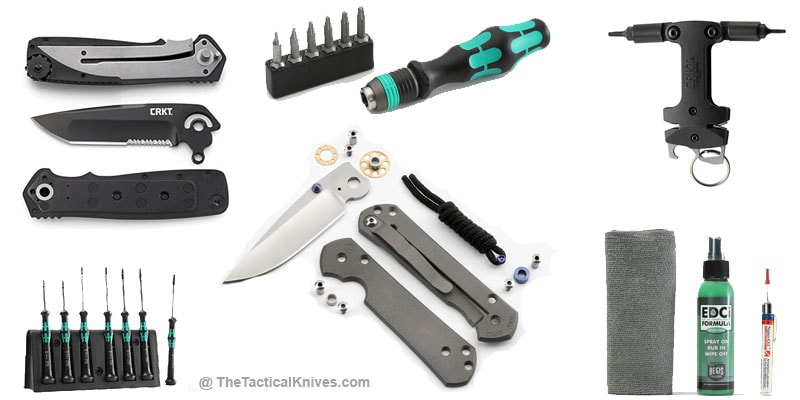
After cleaning, oiling a blade will keep it from rusting and maintain its sharpness. Oils made for knives are ideal, however, sewing machine oil can double instead if needed.
In fixed blade knife caring, if the knife has a leather grip or sheath, the leather should be oiled as well. Avoid oils that advertise moisture-retaining or adding quality, as moisture should be avoided as much as possible to keep oxidation away.
Unless the knife is properly sealed, don’t use the knife underwater unless necessary. If a knife is used underwater, immediate cleaning should be done to keep the water out.
What Can Damage A Tactical Knife?
There are many things that can damage your tactical knife. For example –
- Leaving knife unused for long periods of time
- Cutting on a hard surface
- Regular abuse without special need
- Do not use a specific tactical knife for a specific task
- Abusing the tip as a chisel, screwdriver, or pre-bars
- Throwing the tactical knife
- Using a knife that is not full tang as hammers
- Heavy batoning for firewood
- Improper sharpening
- Not maintaining the tactical folding knife regularly and properly
- Storing it wet or leaving it in a drying place
More details on my “Ways You Might Be Ruining Your Tactical Knives” page.
How to Sharpen a Tactical Knife?
The blade of a tactical knife can be plain or serrated or combo edge. So I am trying to discuss below separately how to sharpen plain and serrated edge blades.
Plain Blades: A properly sharpened knife is paramount to ensuring its quality and functionality. To sharpen any knife, a proper whetstone or knife sharpening stone system must be selected. For dull knives, a coarser stone, such as a 220 grit, should be selected. Later, when the knife is sharper or if the blade is already a bit sharp, finer grits, typically between 600 and 1000 grit, should be used.
A whetstone should be wet with either cooking oil or water, just enough to soak in. Find the correct angle of the blade, lay the blade flat on the stone, and raise it to the correct angle. Run the blade along the stone with gentle force, keeping the same angle. Repeat with the other side and repeat it all as needed. Lightly oil after completion.
Serrated Blades: Unlike plain blades, serrated blades cannot be sharpened as easily. Serrated blades require a sharpening rod rather than a whetstone. A sharpening rod can be used for a plain blade, however, if one is unused to the motion it may be more difficult.
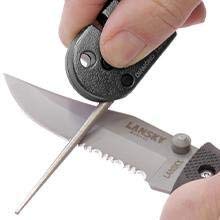
Using the proper grit, align the first serrated section with the rod. Find the correct angle of the blade, or the bevel, and run the blade down the rod a few times. Repeat this on the other side and proceed to the next bevel. After sharpening all bevels, rune a fine whetstone along the flat edge to remove the burs from it. Lightly oil after completion.
You May Like: Best Combo Edge Folding Knife
Who Makes the Best Tactical Knife?
The best tactical knife is often subjective, dependent on the intended use and person.
Between fixed and folding blades – Kershaw, Smith & Wesson, CRKT for affordable folding; Zero Tolerance, Spyderco, Benchmade for high-end folding knives; and Gerber, Cold Steel, SOG make both knives that are good quality, as well as their price range, is medium.
The best tactical fixed blade knife, in general, could be construed to have been made by Ka-Bar and SOG.
What is the Best Tactical Knife Brand in the World?
Overall, despite having some design flaws or quality complications, SOG continually produces high quality tactical knives. Throughout various budgets and types, SOG has knives that will be quality, functional, and durable.
In general, SOG can be difficult to go wrong with, even if it doesn’t make the number one knife, all of its fixed and folding tactical knives are good quality. Although I remain quite partial to Columbia River Knife and Tool (CRKT).
I have reviewed and recommended some of the top products based on the knife company, you can take a look if you want.
- Best SOG Knife
- Best KA BAR Tactical Knife
- Best Zero Tolerance Folding Knife
- Best Buck Skinning Knife
- Best Folding Knife Brands
- Top Rated Fixed Blade Knife Brands
How to Attach a Tactical Knife to Molle Webbing?
Attaching a knife to Molle webbing does not require much. A strap or adequate clip, often specially made for this purpose can be used. A strap may have a snap or other button attached. Take this strap and run it underneath the webbing.
If you would like to attach it to multiple rows of webbing, slide it beneath those as well. Once completed, re-snap or secure the strap to the attachment. The knife should be secure and easily accessible as needed.
How to Attach a Knife to a Tactical Vest?
Tactical vests have a plethora of attachment methods. Often using MOLLE, one can attach a knife in a similar manner as formerly explained.
Alternatively, there are sheaths and clips designed to attach to the vest. By slipping a clip, strap, or sheath beneath the webbing, one can easily attach a variety of blades.
What Type of Tactical Knife Does the Army Use?
The army uses a multitude of tactical knives, depending on what is required. The Navy Seals utilized sealed, underwater capable knives, and the Marine Corps used Ontario MK3.
Most units will use fixed blade knives, due to their durability and heavy-duty functionality which won’t fail on the battlefield.
Some of the most commonly used tactical combat knives are-
- Ka-Bar USMC Fighting Knife
- Gerber Mark II Knife
- M7 or M9 Bayonet Knife
- Ontario MK3 Navy Knife
- SOG Seal Pup Elite Tactical Knife
Final Verdict
Tactical knives are good knives for all situations. If someone needs a knife that will serve them well in a variety of situations, tactical knives are the best option.
For most people, especially outdoor hobbyists, a fixed blade knife will serve best. However, for those wishing to casually carry a blade, a folding knife will serve better.
Ultimately, whichever is chosen, a tactical knife will not fail you when needed.
